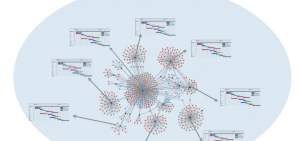
Today’s post is by our Founder, Dr. Domenico Lepore.
We have been writing extensively about the benefits of a design that mirrors the inherent project nature of the work of any organization. We call it the ‘Network of Projects’ organization design.
The steps to build a Network of Projects organization are:
1) Recognizing that organizations are Systems, Networks of interdependent components that work together for a well stated and commonly agreed upon goal. The components making up the organization are its processes(mainly repetitive) and its projects(inherently “one off”).
2) In any System, we can maximize speed of flow by leveraging a finite element called the “constraint”. Hence, if we want to maximize the speed of flow, i.e. what our organization can achieve, we must account for what maximizes flow through its components.
3) We can maintain maximum speed of process through the management of variation; Maximum speed of project flow is achieved by orchestrating available resources (and the multitude of their competencies) at finite capacity, i.e. avoiding resource contention and by instituting polices and performance management measurements consistent with this orchestration. It is called CCPM, Critical Chain Project Management.
4) The Critical Chain is “the constraint” of the project; it is the longest sequence of dependent events that takes into account the availability of resources (and competencies). Disrupting the constraint is what debases performance so the constraint (the Critical Chain) must be protected. We call this protection “Buffer”and it must be placed at the end of the chain (NO milestones, we protect the whole, NOT the parts) and its oscillation (consumption/elongation) must be understood statistically.
5) Statistical understanding of buffer oscillation provides insight into the development of the project and early warning for potential delay.
6) By arranging (scheduling) all the available competencies in the organization into a “network of projects” we maximize both the speed of flow and the impact that these competencies can have on the bottom line.
Buffers provide the control mechanism to protect against disruption, statistical understanding of project development and early warnings on potential delays and are normally measured in time. Simply put, buffers cumulate protection from variation associated with the execution of every task. In this way, they provide a time “shield” against delay.
The statistical property that buffers leverage is called covariance; let’s say that it is a very efficient way to “pool” time.
How about money?
A company viewed as a Network of Projects is a natural evolution of W. Edwards Deming’s original 1952 system design. Each project is protected with a time buffer. Success in project execution is measured in terms of timeliness, adherence to specs and cash outlay; the first two are peculiar to each project but cash can be pooled to protect the entire Network of Projects.
Said in a different way: the money buffer that protects each project from variation in cash outlay (typically, Totally Variable Costs, TVC – the subset of the inventory that goes into a project) could be pooled in a buffer that protects ALL the projects. Covariance holds for money too.
The rationale for this choice is mathematically obvious, less so its organizational implications. Pooling resources is a systemic concept; it comes from a paradigm of whole system optimization and the reconciliation of the inherent conflict between Local Vs Global performance measurement.
Pooling cash to protect the entirety of the network of projects (enabling maximization of results) is possible only if we abandon the idea of “functional budgeting” and cost centers. We can take intelligent decisions about how we invest our money only if we take intelligent decisions about how we want to work.
Ignorance (of how to do it) is a curable condition; Stupidity (deciding to ignore reality) is a choice.
Intelligent Management, founded by Dr. Domenico Lepore, helps leaders in organizations to speed up flow, overcome silos, and shift towards a systemic way of working based on win-win collaboration and transparency. We are trusted advisors to leaders of organizations through our unique, whole system Network of Projects organization design. Sign up to our blog here. Intelligent Management provides education and training internationally on systemic management using the Decalogue methodology .
See our new books The Human Constraint – a business novel that has sold in 28 countries so far and ‘Quality, Involvement, Flow: The Systemic Organization’ from CRC Press, New York, by Dr. Domenico Lepore, Dr. Angela Montgomery and Dr. Giovanni Siepe.





Leave a Reply